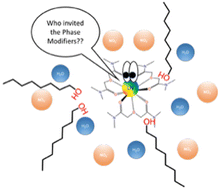A multi-faceted approach to probe organic phase composition in TODGA systems with 1-alcohol phase modifiers†
Abstract
The effect of varying 1-alcohol alkyl chain length on extraction of lanthanides (Lns), H2O, and H+ was studied with tetraoctyl diglycolamide (TODGA) via solvent extraction coupled with FT-IR investigations. This multi-faceted approach provided understanding regarding the relationship between extracted Lns, H2O and H+, 1-alcohol volume fraction, and 1-alcohol alkyl chain length. Under acidic conditions there is competition with 1-alcohols and their ability to solubilize aggregates and incidentally induce third phase formation by increasing the extraction of H2O. At low 1-alcohol concentrations (5 vol%), the trend for 1-alcohol alkyl lengths in solubilizing the aggregates is 1-hexanol > 1-octanol > 1-decanol. Shorter alkyl chains suppress aggregation, ultimately resulting in lower H2O concentrations and less available TODGA to hydrogen bond with H+. Increasing the 1-alcohol concentration to 30 vol% results in the opposite trend, with longer alkyl chains suppressing aggregation. These results suggest this approach is effective at probing trends in the organic phase micro-structure, and indicates trends across the Ln period with various 1-alcohol alkyl chain lengths are a function of outer-sphere coordination.

- This article is part of the themed collection: Metal extraction and recycling


 Please wait while we load your content...
Please wait while we load your content...